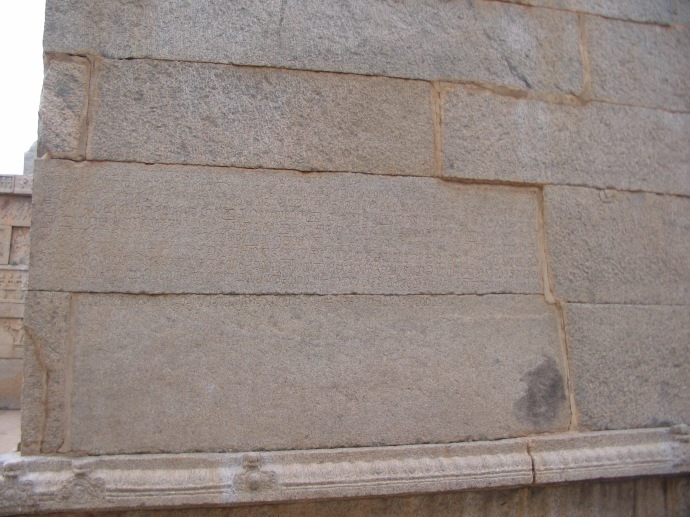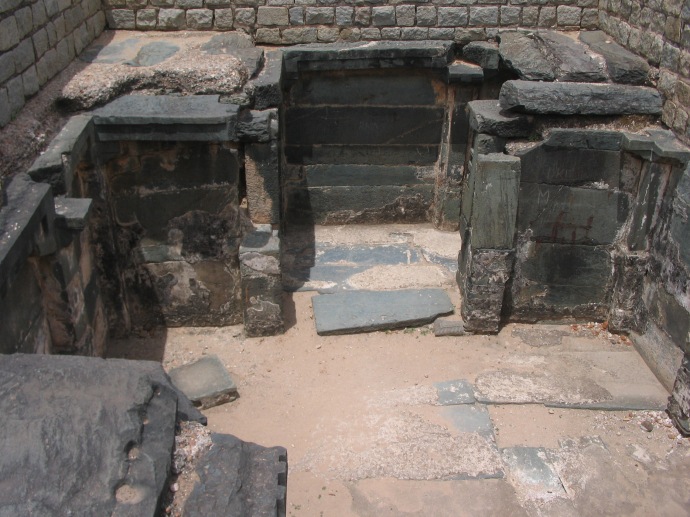Mantralaya – Hampi (2 days) – June 2012 – Day II
The next stop was the Zenana complex, or the women’s complex. It was a bit surprising initially to hear an essentially mohammedan name given to a complex belonging to Hindu rulers. But the main feature of this complex are Indo-Islamic in nature. Hence the name reflects this aspect.
On the way to the complex the Mohammedan Watch Tower, Mint, and Mosque were pointed out. It was a bit dicey to claim we actually saw it. It was pointed out through the windows of a moving bus after all! 🙂
The first feature pointed out at the Zenana enclosure were the surrounding wall. The outstanding feature of the walls was that no mortar or limestone was used. It is literally a dry wall. The stones were selected to be of a certain size and weight, and placed in particular positions over each other with no gaps. Net result: walls that have lasted through centuries of neglect and destruction.
To enter one must buy tickets at the entry point. These tickets are valid right up to the Vitthala Temple. S one mustn’t throw them once bought, at least till the end of day! 🙂 The tickets are only Rs. 10 per person. One thing about the ticket is that it features images from other World Heritage Sites in India, giving their names and locations on the reverse of the ticket. Must say, it’s a decent attempt to drive tourism!
One entering, you can see a small museum on your far left along the wall. This was originally thought to the be the treasury, but now houses artifacts. Nearby you can see a large platform. This plinth is all that is remaining today of the Queen’s palace. From the size it is evident that it would have been a huge, grand structure. The only possible reason for the the base to be saved, was that the base was made in stone, but the building itself was made of wood. On the opposite side of the walking lane is a wide tank, and another palace base, though smaller, is placed within it. This was the palace of the younger queen.
Nearby was the famous Lotus Mahal, which was used for entertainment. A fine example of using natural resources to make life more pleasant. There was a moat all around this building to ensure that the water sent cool air into the building. Also there were pipes and passageways (now destroyed through neglect) to carry water to the upper floor and ensure an air-conditioning-like effect. The beauty lies in the fact that all this was constructed in our ancient past!
Further on are the elephant stables. It’s a huge structure, and though a common need in those times, it’s a major attraction as we probably don’t see anything like it in use nowadays! What interested me was a nearby building. These were the rooms for the mahoots and other workers at the elephant stables. But the structure was build unusually high, compared to the other palaces on the grounds. Also the front on the building had a narrow platform along the length. This was to help the mahoots to climb onto the elephants directly, without having to use ladders!
On coming out, we found yet another vendor of yummy lemon soda. After guzzling down this cooler, we went back to our bus, and headed to the Hazara Rama Temple.
This was the temple meant for royal use. The placement of this structure in close to the ceremonial complex. So the idea was that the king/emperor would worship at the temple at then proceed to perform his duties for the day. The temple got its name for the sheer number of images of Lord Rama depicted within the temple complex. The temple is constructed with a light-colored stone, light granite I think. But in the interior of the temple, black Cuddupah stones are used for pillars in the mandapa. These were possibly brought over from present-day Andhra, as this type of stone is unavailable in this region. It certainly forms a beautiful contrast to the light stone all around.
The main feature of the temple is the story of the Ramayan depicted in 3 tiers all around the temple, and the story of Luv-Kush around the Devi’s shrine. Also along the inner wall to the right, the Kamba Ramayan is written in Tamil (?). The idea was that Lord Rama was the ideal king, and every leader should try to emulate him. But a king doesn’t have the time to read the story everyday. So the images were a way for the king to read the whole story everyday, without actually reading it, and is reminded of his goal (of becoming like Rama) everyday.
From here we walked across to the palace complex. We entered through the side entrance, close to the Hazara Rama temple. Here, everyone climbed up a large platform. Unfortunately, while climbing, my ma-in-law injured her leg. So we sat out the explanations, right upto the dining hall. What we saw on the way there was an underground room. The construction was quite interesting, but I’d missed the explanations.
At the ‘dining hall’, large aqueducts lined the sides. Near these were large stone plates. These even had notches to separate out the curries and sweets from the rice (hopefully). After the meals were done, water from the aqueduct was used to wash the ‘plates’ making life really comfortable for the servants, given the sheer number of people who would have had meals here.
The next stop was the step-well. This construction was done in Rajasthani style, and un-heard of in South India. A truly beautiful structure. Since we had gone during summer, the well was dry, letting us see the well in its entirety. The step-well was fed through a huge stone aqueduct. When the aqueduct was excavated, people found that one edge was pointing downwards. On digging where the duct lowered, this step-well was found.
2 important things stand out regarding this tank. One is the symmetry of the design. It can be viewed as a V or an inverted-V. It is perfectly balanced in this aspect. Secondly, each of the stones bears a mason’s mark or symbol, which means the well was pre-fabricated! And we thought pre-fabrication was a new concept!
The next stop was the Mahanavami Dibba. This was essentially an elevated platform for the king during ceremonial occasions, particularly during the navaratri celebrations of Dassera. hence the name Mahanavami Dibba.
None of us had the energy to climb up all the steps, esp me on an empty stomach! 😉 So we took all the requisite photo from down itself.
We came out of the complex from the main entrance. Outside are 2 huge stone doors lying on their side. in fact I’d ignored them until our guide brought them to our notice!
Next stop was the Queen’s Bath. Here I was running out of energy so I didn’t go in, just relied on the hubby’s review! 🙂
Next stop was lunch at the Hotel Mayura Bhaveshwari. Lunch was a buffet affair. We were also given sealed 1/2ltr water bottles with the meal. Quite nice, and a simple fare.
From here we made our way to the famed Vitthala Temple.

















